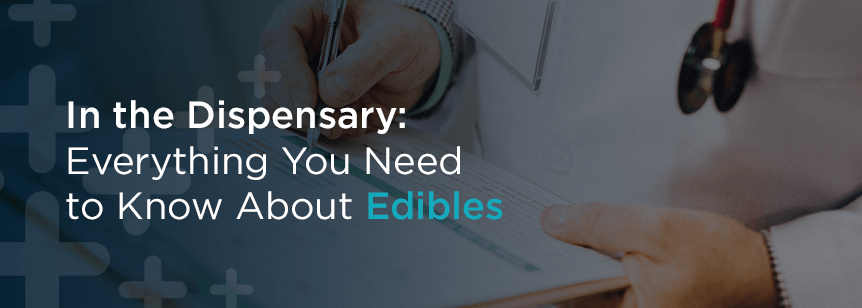
Back in the 1950s, writer Alice B. Toklas created a little bit of notoriety when she published a cookbook with a recipe for marijuana brownies. In the 1968 film, I Love You Alice B. Toklas, a hippie and her hash brownies seduce a strait-laced man played by Peter Sellers.
These days, edibles are just another way of ingesting marijuana. They are available in a host of shapes and forms, from cookies, gummies, brownies, caramels, hard candies and chocolates to Rice Krispies treats. As laws continue to relax, companies are also making THC-infused drinks, including coffee, tea, and sodas.
Edibles aren’t always food or drink spiked with cannabis. They also include tinctures, where a few drops are placed under the tongue; as dissolvable powders to be mixed into drinks or into food; and as capsules, which would be taken the same way as any other medication or supplement.
Edibles have proven popular with customers. In Colorado, for example, which was one of the first states to relax their laws regarding recreational use, edibles account for 20% to 40% of cannabis sales.
The major benefit of edibles is being able to use marijuana without having to smoke it, which can be bothersome for many. Finding a place to smoke outside the home can be difficult, with increasingly restrictive laws, but consuming edibles is easy and can be done anywhere a person would normally eat or drink. The downside of ingesting cannabis is that it is absorbed through the digestive system, so the effects take longer to kick in compared to smoking or vaping, which have near-immediate effects. Effects can be felt as quickly as 45 minutes after consuming an edible, or up to 3 hours later. Effects may last anywhere from 4 and 6 hours.
Another drawback to edibles is that they offer less control over dosage compared with smoking. Since smoking takes effect very quickly, a person can stop when he or she feels that they have had enough, or take a pause, wait, and then resume if more is needed. With edibles, there is a lag time, and once ingested there’s no turning back from an excessively high dose, while if a dose is too low, a person may need to wait several hours to see if they need to take more.
But regardless of the drawbacks, edibles are extremely popular. With all these different types of edibles available, it can be confusing when it comes to selecting a product. Figuring out the right dose can also be tricky.
According to Ean Seeb of the central Denver dispensary Denver Relief, customers should be aware that the tolerance level from smoking doesn’t necessarily translate to eating marijuana. In other words, a high smoking tolerance doesn’t equal a high tolerance for edibles. A person’s individual characteristics will also affect the dose that a person needs. As with any other medicine, amount of body fat, age, gender, metabolism (fast or slow), and individual body chemistry can all play a role in determining the effect. You should discuss this with your budtender or marijuana doctor. Also, don’t take edibles on an empty stomach.
The actual dose per edible can vary considerably. The 3D Cannabis Center in Colorado considers 10 milligrams to be a unit or dose of THC. So how does that work in real life, when you’re trying to figure out how much of that chocolate bar you should eat? Basically, the amount of activated THC needs to be calculated in each piece or square. If the chocolate bar as a whole contains 100 milligrams of THC and is split into 10 pieces, each piece contains about 10 milligrams. Some foods may be more difficult to figure out if they can’t be divided so easily.
Also consider CBD:THC ratio. Edibles come in a wide range of ratios. 0:1, for example, contains only THC, while 1:0 contains only CBD. Generally, the more THC in relation to CBD, the more psychoactive effects will be felt, while when CBD predominates effects tend to be more calming and relaxing. The THC dose is the most important when deciding how much to consume.
The full dose of THC or CBD should be labeled on any product that is sold commercially, and these doses can be high. Candies, for example, can contain anywhere from 5-30 milligrams of THC or CBD, or even more, and larger edible products will undoubtedly be more potent. Edibles generally do come with warning labels to assist people in understanding the dose and to prevent ingesting too much.
If you’re new to edibles, begin with an initial dose that contains 5 mg THC and wait 24 hours to see what the effect is. The dose can then be raised by 2.5 or 5 mg every 24 hours until you feel the effects. This is the “minimum effective dose.”
Individuals with some cannabis experience can start with 5-25mg, while very experienced users can begin with 20 mg or above. But remember, everyone’s body interacts differently with the cannabinoids in edibles, so proceed with care.
Roxanne Nelson is a registered nurse who has written for a wide range of publications for healthcare professionals and consumers, including Medscape, The Lancet, Prevention, Scientific American, WebMD, American Journal of Nursing, Frontline, National Geographic, Hematology Adviser, American Journal of Medical Genetics and the Washington Post, among others.
No Information on MarijuanaDoctors.Com should be used to diagnose, treat, prevent or cure any disease or condition. You can view our Full Disclaimer here.